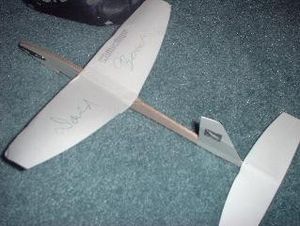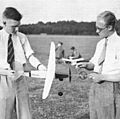Model airplane facts for kids
A model airplane is a small aircraft that doesn't have a pilot inside. It can be a tiny copy of a real airplane or a made-up design.
Model aircraft are usually split into two main types: those that fly and those that don't. The ones that don't fly are often called static, display, or shelf models. Flying models can be simple toy gliders or detailed, powered models. Some flying models can be very big, especially when they are used to act like real planes. Static models can be mass-produced toys or very accurate models for museums.
Aircraft makers and scientists use special models in wind tunnels. These models help them test new designs and improve existing ones. Sometimes, they only model a small part of an aircraft for testing.
Contents
Static Model Airplanes
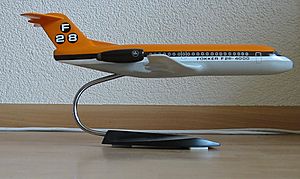
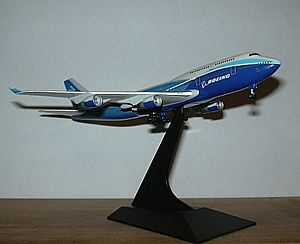
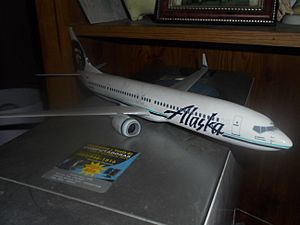
Static model airplanes are models that are not meant to fly. They are scale models, meaning they are smaller versions of real aircraft. These models are built using materials like plastic, wood, metal, or paper. Some static models are made to a specific scale for use in wind tunnels. Data from these tests helps engineers design full-sized airplanes.
Collectors can buy static models in different ways. Some models are already built and painted. Others need to be put together, painted, and glued. There are also "snap models" that are painted but just need to be snapped together. These snap models are easy to build and are becoming very popular.
Models for Promotion
Many airlines around the world let companies make models of their planes. This helps them advertise their airline. In the past, airlines would order large models of their aircraft. They would then give these models to travel agencies to help promote their flights.
Understanding Scale
When we talk about "scale" in static models, it means how much smaller the model is compared to the real plane. For example, a 1:72 scale model is 72 times smaller than the actual aircraft.
For static models, the most common scales are 1:72 and 1:48. The 1:144 is popular for models of passenger planes. You can find more detailed models in 1:32 and 1:24. Some companies also make models in 1:50 and 1:30 scales. In Japan, 1:100 scale models are common.
How Models Are Made
The most common way to make model kits is by injection molding plastic. This process uses special molds made from carbon steel. Today, most of this work happens in countries like China and South Korea. Injection molding allows for very precise and automated production.
Another way models are made is by casting resin. This uses silicone rubber molds. This method is more hands-on and often used for unique or less common aircraft. These resin models are usually more expensive because they take more work to make.
Some models are made from paper or card stock. These are often printed by publishers, especially in Eastern Europe. You can also find many free paper model designs online. Paper models aren't just for aircraft; you can find them for cars, buildings, and even animals!
From the time of World War I up to the 1950s, many model airplanes were made from lightweight balsa wood. They were often covered with thin tissue paper. This was a challenging and time-consuming process.
Today, you can also buy ready-made models. These are often called "desk-top models." They can be made from materials like fiberglass, die-cast metal, or plastic. Snap-fit plastic models are also a type of ready-made model.
Flying Model Airplanes
When people talk about aeromodelling, they usually mean flying models. Most flying model aircraft fit into one of three main groups:
- Free flight (F/F) models fly on their own without any connection to the ground. This type of model existed even before the Wright brothers made their first successful flight.
- Control line (C/L) models use thin wires (usually two) that connect the model's wing to the pilot on the ground. The pilot controls the model by moving these wires.
- Radio-controlled aircraft (RC) models are controlled by a pilot using a transmitter. The transmitter sends radio signals to a receiver inside the model, which then controls its movements.
Some flying models look exactly like smaller versions of real airplanes. Others are designed just for flying and don't look like any real aircraft. You can even find flying models of birds or flying dinosaurs!
Images for kids
-
A Boeing 747 display model.
-
A flying model of a WW1 Royal Aircraft Factory S.E.5a, made from a kit.
-
A "Giant scale" 18 feet 6 inches (5.64 m) wingspan Lockheed C-130 Hercules radio control flying model.


